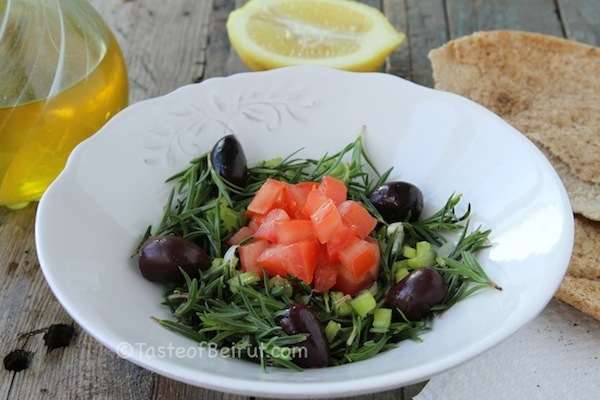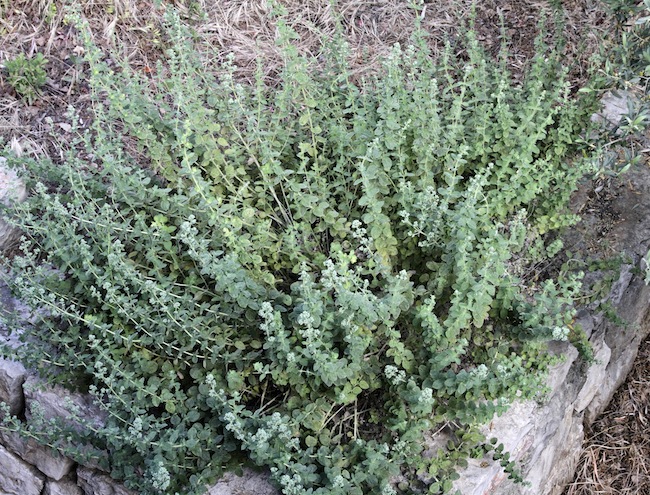Zaatar salad (salatet zaatar akhdar)
August 16, 2013 • Category: Salads

Zaatar comes in many varieties in Lebanon; heard from a couple of sources that the total count was in excess of 133! The one above is called green (akhdar), and gets foraged and used in salads. The equivalent could be wild savory. It is pungent and good with grilled meat as well. Chef Mattar has a recipe in which she makes a pesto out of it. Real good.
The difference between this zaatar and the one that ends up as a mix with sumac and sesame seeds, is this one is either consumed fresh or gets pickled; the pickles can be found at the Middle-Eastern grocers in the US; pickled zaatar is good added to a feta or labneh salad or mixed as a condiment with other foods.
The salad here is very traditional and typical of village food.
This zaatar bush above is for the variety that ends up as a dry mix.
Comments
15 Comments • Comments Feed


Rosa says:
A wonderful salad! So flavorful and delightfully herby.
Cheers,
Rosa
On August 16, 2013 at 12:28 am
Nadege says:
I am not going to Lebanon anytime soon; I just have to find a good Lebanese restaurant in Los Angeles. This refreshing salad really looks lovely!
On August 16, 2013 at 9:14 am
Mark Wisecarver says:
Mmmm…Served with Olive Oil, Humus and Pita, Delicious!
On August 16, 2013 at 11:24 am
Katerina says:
Hi Joumana! I have heard many times of Zaatar many times and I am so curious! I will have to try and make it sometime!
On August 16, 2013 at 11:28 am
Jay says:
What is the scientific name of wild savory? It looks like rosemary or a close relative.
— jay
On August 16, 2013 at 1:56 pm
sippitysup says:
Isn’t there also a spice blend called zaatar? Or am I missing your point. Hey’ maybe that’s the one with “sumac and sesame seeds”. Also sometimes I see an apostrophe in the word. Since I don’t know where the apostrophe goes, I left it out here. How deep is the hole I’m digging now? XOGREG
On August 16, 2013 at 5:35 pm
Joumana says:
@sippitysup: yes, zaatar is the name of the spice mix as well; the spice mix uses a different variety of the wild herb, called origanum syriacum. the one used for salad is not made into a spice. each variety has a slightly different taste and smell.
On August 16, 2013 at 11:33 pm
Nidal says:
Joumana,
La remarque de Jay me paraît judicieuse !
C’est vrai que la plante que je vois dans la salade me fait plus penser au Romarin “Rosemary” qu’au “Thym”.
sippitysup a également raison de relever la nuance (amalgame) entre la plante Zaatar et le “Spice mix”, appelé également Zaatar.
On August 18, 2013 at 11:43 am
Hilda says:
Hello Joumana. A quelle plante aromatique correspond le zaatar en France ?? Dans la salade les feuilles ressemble effectivement à du romarin mais ce dernier à un parfun et un goût très prononcés et très differents du thym. En revance sur la photo de la plante les feuilles rappelle l’origan ??? Alors à quoi correspond le zaatar ??. Amitiés
Hilda
On August 19, 2013 at 10:50 am
Joumana says:
@Hilda: ça depend; il faut demander a un jardinier en France; il y a des dizaines de variétés; celui qui est le zaatar en poudre s’appelle origanum syriacum. celui dans la salade c’est le savory. je ne connais pas le nom en Français.
On August 19, 2013 at 2:35 pm
Oui, Chef says:
All my favorite flavors in one gorgeous salad!
On August 19, 2013 at 1:40 pm
Jay says:
Merci, Nidal. A web search turned up nothing as did wikipedia. The Texas climate seems good for za’atar (Origanum syriacum ) so I believe it would for this if I could identify it.
Sorry to be a pedant, but local common names can be confusing. I have a friend who grew up on a farm in Lebanon. I’ll see what he knows.
On August 20, 2013 at 11:45 am
Hisham Assaad says:
Ah! I love zaatar. I love it in this salad, i love to have it with white cheeses or labneh.
It’s amazing
On August 22, 2013 at 5:31 am
allison says:
Did anyone identify the scientific name for zaatar akhdar? I’d like to try and grow it in Canada.
On January 4, 2015 at 2:54 pm
Joumana says:
@allison: if you are referring to the zaatar with long leaves that is either pickled or made into a salad, not the spice mix then I need to make sure and the book that I have (somewhere) is not to be found. I looked at two reference books and one says thymus hirsutus. the one made into the mix is called origanum syriacum and origanum libanoticum, although it is the syriacum we use in the Chouf. Once I get a hold of this book I will tell you for sure. The book was a study done at the AUB on the edible wildflowers in Lebanon and the zaatar akhdar is listed.
On January 5, 2015 at 3:13 pm